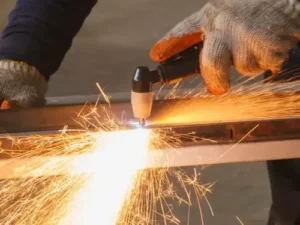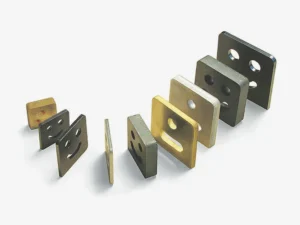Introduction:
Cutting sheet metal is vital in all fields that need precise metal parts. There are several ways of cutting metal sheets. These methods make metal parts used in everything from buildings to complex machinery. Plasma and laser cutting are two popular methods in this case. To find the most suitable method, learning more about “laser cutting VS plasma cutting” is necessary.
Laser and plasma cutting are popular ways to work with sheet metal. Each method has pros and cons, so picking the right one for your job could be tricky if you need to learn more about it.
This article mainly discusses the pros and cons of these two ways of cutting. It shows which way would work best in a particular situation. Knowing this lets you pick the best cutting machine for your job.
Understanding Sheet Metal Cutting
Sheet metal cutting is a metal-forming process. It generally cuts metal sheets to give them a desired shape or size. People use various cutting methods to do this. Laser cutting, plasma cutting, waterjet cutting, and shearing are noteworthy. However, these methods are crucial for creating complex parts used in multiple industries.
Nevertheless, people pick the most suitable option based on various factors. For instance, laser cutting is popular because it makes perfect cuts. Plasma cutting, on the other hand, is used to cut thick metals.
Crucial Factors to Consider During Sheet Metal Cutting
When you choose the correct method for your project, it is essential to know some factors. Carefully considering these factors can help you select the proper sheet metal cutting method. Eventually, you will be able to achieve the results you want.
- Different metals have different properties. So, the best way to cut metal depends on the type of metal.
- Precision and accuracy are crucial factors. It ensures that every part fits perfectly and works as it should.
- When working with sheet metal, you must consider material distortion and warping. So, choose a cutting method that produces minimal HAZ.
- The edge quality resembles how the finished product looks.
- The production time affects the choice of cutting method.
- Machines and processes that cut sheet metal use a lot of energy. So, safety is the most important thing when working with sheet metal.
What is Laser Cutting?
As the name implies, this cutting method uses a laser to cut sheet metal. A laser is a highly focused beam that can melt and vaporize the surface on which it is being projected. This concept generally comes in handy in sheet metal fabrication.
Laser cutting offers numerous benefits. Firstly and most importantly, it is renowned for its high precision. This method can handle complex patterns with tight tolerances.
Laser cutting is also famous for its versatility. It can be used on various materials, such as metals, plastics, wood, and ceramics. It is a non-contact process, which means that it creates minimal distortion. This ensures high-quality cuts. Moreover, laser cutting is highly efficient. It cuts things quickly and doesn’t make much waste.
What is Plasma Cutting?
Plasma cutting is a thermal cutting process. As the name suggests, this method uses plasma, an ionized gas, to cut sheet metal. Plasma cutting generally uses high-velocity plasma to cut through metals. Note that plasma cutting can only be used on objects that can conduct electricity.

Plasma cutting works excellent for thick materials. A typical 12000W laser cutting machine can cut up to 40mm. But a plasma cutter can cut more.
Plasma-cutting machines are easy to install and require a lower initial cost. However, they need refills, which could add up over time.
This cutting method is often found in various metal fabrication shops. Handheld plasma cutters are usually popular.
Laser Cutting VS Plasma Cutting: Which is the Best for Sheet Metal Parts?
Both laser and plasma cutting are well-known in the sheet metal cutting business. However, each approach has unique benefits if you consider what works best. Because of these perks, they are usually suitable for specific purposes. Check the table below for an overview of these two renowned sheet metal cutting methods.
| Aspect | Laser Cutting | Plasma Cutting |
| Cutting Method | It uses a high-powered laser beam to melt and vaporize material along a precise path. | It uses a high-velocity ionized gas (plasma) jet to cut through electrically conductive materials. |
| Material Compatibility | Works well with a variety of materials, such as metals, plastics, wood, and more | Primarily suitable for conductive materials, such as steel, aluminum, copper, and other metals |
| Accuracy | Provides high precision and intricate detailing. It is suitable for complex shapes. | It generally offers good precision but may have slightly rougher edges than laser cutting. |
| Speed | Generally, cutting speeds are faster, especially for thin materials. | Slower cutting speeds compared to laser cutting, particularly for thicker metals |
| Heat-affected Zone (HAZ) | Produces narrow HAZ, reduced distortion, and material damage | It may generate a wider HAZ, may create warping or deformation |
| Edge Quality | Results in clean and smooth edges. You may not require additional finishing. | It may produce rougher edges. You may require additional finishing, such as sanding. |
| Thicknesses | Suitable for thin to medium-thickness materials, typically up to 40mm | It is ideal for cutting thicker metals, typically not suitable for thinner metals |
| Maintenance | Requires less maintenance | Requires frequent maintenance |
| Operating Costs | Generally, higher initial costs but lower ongoing costs | Lower initial costs but higher operating costs |
| Environmental Impact | Produces minimal waste and emissions | Produces smoke, noise, and slag |
-
Laser Cutting VS Plasma Cutting: Accuracy & Edge Quality
Laser cutting generally offers higher accuracy. Every cut can reach a tolerance of up to ±0.01mm.
Laser cutting creates superior edge quality compared to plasma cutting. As a result, you may need additional finishing.

Laser cutting uses a highly focused laser beam. This technically creates cuts with minimal HAZ. It results in clean, smooth edges.
On the other hand, plasma cutting produces rougher edges and wider HAZ. Although it can cut thicker materials, post-processing may still be needed to achieve the desired edge quality.
-
Laser VS Plasma Cutting: Which is faster?
Laser cutting is generally faster than plasma cutting. It uses a highly focused laser beam to penetrate the metal surface. It can quickly create cleaner cuts with minimal distortion. Eventually, it improves the production time. Because of this, laser cutting is prevalent in many industries.
On the other hand, plasma cutting can be faster for cutting thicker materials. It typically operates at slower speeds compared to laser cutting.
Plasma cutting may not be as fast or accurate as laser cutting, even though it costs less. This method is not recommended for situations where speed and accuracy are critical. Because of this, laser cutting is often the best choice for faster cutting speeds and better accuracy.
-
Plasma Cut VS Laser Cut: Materials & Thicknesses
Laser cutting is a versatile method. In contrast, plasma cutting can only cut material that can conduct electricity. But when it comes to metal, both ways of cutting work well.
Both cutting methods can handle various metal thicknesses. The table below shows how different laser power levels work with varying amounts of material.
| Metal | 1000W | 1500W | 2000W | 3000W | 4000W | 6000W | 8000W | 12000W |
| Carbon Steel | 8 mm | 10 mm | 14 mm | 18 mm | 20 mm | 22 mm | 25 mm | 35 mm |
| Stainless Steel | 4 mm | 5 mm | 6 mm | 8 mm | 10 mm | 18 mm | 20 mm | 40 mm |
| Aluminum | 2 mm | 3 mm | 5 mm | 8 mm | 10 mm | 16 mm | 20 mm | 30 mm |
If you are dealing with thin to medium thicknesses of metals, you’d better go for laser cutting. It would be the cost-effective way to achieve a clean cut. However, if you are dealing with thicker metals, you better choose a plasma cutter.
-
Plasma Cutting Machine VS Laser Cutting Machine: Safety
Since sheet metal cutting involves high energy, safety must be considered first. Plasma cutting creates a lot of heat, harmful fumes, and smoke. Therefore, you should make sure there is enough airflow. You must also be careful not to get burned by the plasma spark.
Conversely, high-power laser beams can pose serious risks, including eye damage and skin burns. You must always wear laser safety goggles and protective clothing to ensure your safety.
Both machines can catch fire or give you an electric shock. Therefore, all safety features must be ensured.
-
Laser VS Plasma Cutting: Cost
Laser cutters generally cost more to buy at first than plasma cutters. They may cost anywhere between a few thousand and one hundred thousand dollars. On the other hand, plasma cutters may cost anywhere between a few hundred and tens of thousands of dollars.
Laser cutters are efficient. They also produce less waste. They do not require frequent maintenance and repair. Because of these, laser cutters require less operating costs. On the other hand, plasma cutters need consumables. They also need frequent maintenance and repair, so it has higher TOC.
Final Thoughts
Laser cutting is the best in overall judgment. Why? Because it gives you the highest accuracy, efficiency, speed, and best quality cut. Although the initial cost may be higher, you can enjoy reliable services in the long run. Plasma cutting, however, is better for cutting the thicker metals. It also has a lower initial cost.
When picking a laser-cutting machine, the brand should be your priority. Remember that a reputable maker can guarantee quality, certifications, and legal rules. ZL Tech is a leading manufacturer of various types of laser cutting machines. For more information, contact us today.
